The technical sophistication of the Middle Ages tends to be underestimated. Near the end of the High Middle Ages, mechanical technology such as clocks and water mills, for example, were becoming quite advanced. A particularly impressive example of this technical skill is the astronomical clock at the old town hall in Prague, the modern-day capital of the Czech Republic. The Prague astronomical clock was constructed in 1410 and contains dials which track the motion of the sun and moon through the year in both Central European Time and Old Czech Time. It also contains elaborate moving sculptures of various allegorical figures and the Twelve Apostles.
The Legend and Truth of the Prague Astronomical Clock’s Creation
According to a now discredited legend, the Prague astronomical clock was built in the 15th century by a clockmaker by the name of Hanus. Hanus apparently made the clock and refused to tell the City Council of Prague how he had constructed it. When the city magistrates discovered that he had designed and planned to construct an even better clock for someone else, they were filled with jealousy and blinded him so that he would be unable to repeat his work. In revenge, Hanus is said to have broken the clock so that it could not be used until a hundred years later, when someone was finally able to repair it.
But the real story of the astronomical clock was uncovered in the 1960s. It showed that the clock was built in 1410 by the clockmaker Mikulas of Kadan in collaboration with the astronomer and professor at Charles University, Jan Sindel. Since then it has broken many times, the first time being in 16th century, when it was repaired and improved by Jan Taborsky.
The Prague astronomical clock was almost scrapped in the 1780s because the maintenance was too expensive. In 1865, it was renovated and a calendar dial was added to track feast days. It was damaged in 1945, as the Nazis retreated from Prague. This prompted it to be repaired again. After this repair, the clock was also changed from Old Czech Time to Central European Time.
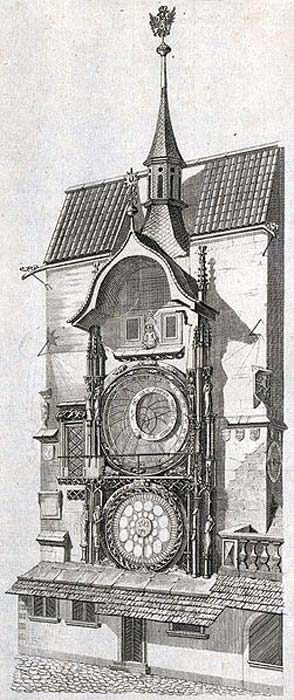
The Prague Astronomical Clock, c. 1791. ( Public Domain )
How Does Prague’s Astronomical Clock Work?
The clock as it exists today consists of two main dials, an astronomical dial and a calendar dial beneath it. The astronomical dial has a zodiac circle, a circle with Roman numerals, and then an outermost circle with Schwabacher numerals, a script that was prevalent in the Middle Ages. There are also gears with symbols for the sun and moon. The background of the dial has an inner blue circle and an outer circle.

Detail of the Prague astronomical clock’s dials. ( Curioso.Photography /Adobe Stock)
The outer circle is blue at the top and black near the bottom. The background is a depiction of the geocentric view of the universe prevalent at the time. The blue circle at the center is the earth and the outer circle is the sky above the city of Prague.
The upper blue part of the circle represents the sky above the horizon and the lower black part represents the sky below the horizon. The sun is above the horizon when it is over the blue part and beneath the horizon when it is over the black part. The innermost ring contains the signs of the zodiac. The middle ring with Roman Numerals represents Central European Time, and the outermost ring represents Old Czech Time.
In addition to the dials, there are also several small sculptures surrounding the clock. These are representations of allegorical figures, which include personifications of vanity, usury, lust, and death. The figure Death announces the passing of the hour by ringing a bell.
Over the top of the two dials is a window where the Twelve Apostles appear in a precession every time the hour strikes. There are also figures of a philosopher, a chronicler, an astronomer, and an angel.
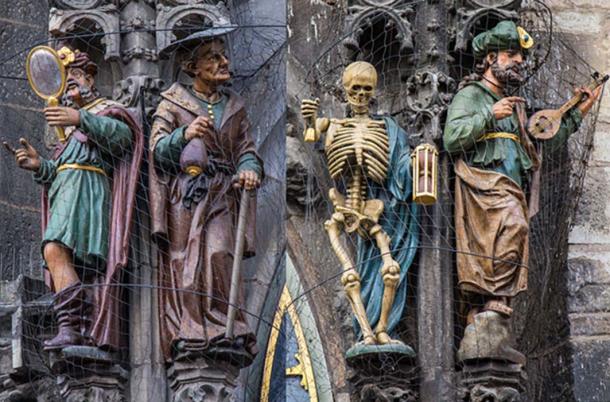
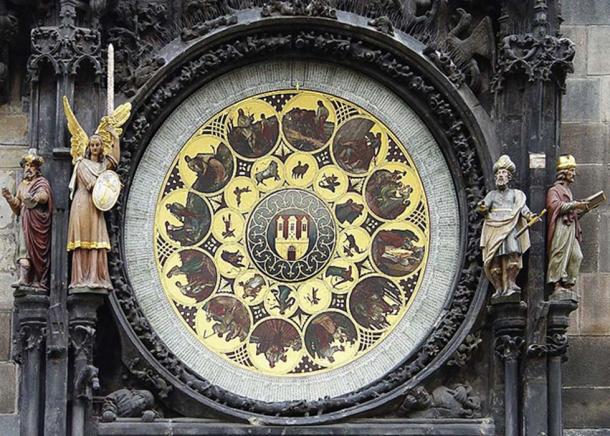
Some of the figures on the clock: Top – representations of vanity and usury ( CC BY SA 3.0 ) death and lust. ( CC BY SA 3.0 ) Bottom – the calendar portion of the clock with a philosopher, a chronicler, an astronomer, and an angel. ( CC BY SA 3.0 )
A Geocentric View
The clock was constructed over 130 years before the publication of On the Revolution of the Heavenly Spheres by Nicolaus Copernicus and thus it presents a geocentric view of the universe. The clock did however represent the cutting edge of science and technology of its day.
Prague’s astronomical clock makes use of the precession of the sun – where the sun, from the perspective of Earth, slowly moves along the ecliptic plane through the year with respect to the background stars. This is represented by the zodiacal circle on which the figure of the sun slowly moves through the same process of precession. It will be over different signs of the zodiac at different times depending on the month and year. The clock also makes use of the daily rotation of the earth, which was perceived at the time to be the daily rotation of the celestial sphere. This is represented in the motions on the clock.
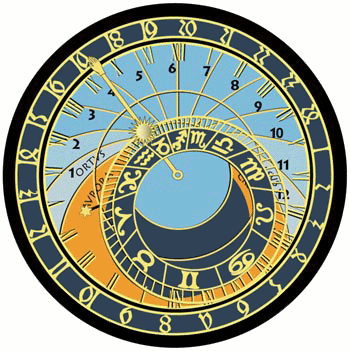
The Prague Clock’s Impressive Automata Use
In addition to the astronomical knowledge manifested in the device, the astronomical clock also demonstrates an impressive use of automata. Several of the sculptures decorating the clock move as the clock operates. For example, whenever the figure of death rings its bell, the other figures shake their heads indicating that it is not yet time for them to leave.
There are also automatons representing the Twelve Apostles passing by the window above the clock. This is all done simply by the clock going through its normal operations. Mechanical automata are a form of analog robots. Most robots today that we are familiar with are programmed digitally. It is however possible to create a robot that is programmed according to non-digital (therefore analog) means such as using strings, gravity, or mechanical gears.
One of the earliest examples of this is a robot built by the ancient Greek engineer Hero or Heron of Alexandria , who created a self-moving cart by wrapping strings around two independent axles and attaching them to a falling weight. As the weight fell, the cart would move depending on the configuration of the strings. The strings essentially represented the programming language of the cart. This is almost identical to how modern robots are programmed digitally.
Scientific advancement in the High Middle Ages was slow and news of scientific discoveries didn’t go far beyond the bounds of the universities and monasteries where most of the work was done. Prague’s astronomical clock, however, shows that science and technology in the High Middle Ages may have been more advanced and developing faster and earlier than previously believed.
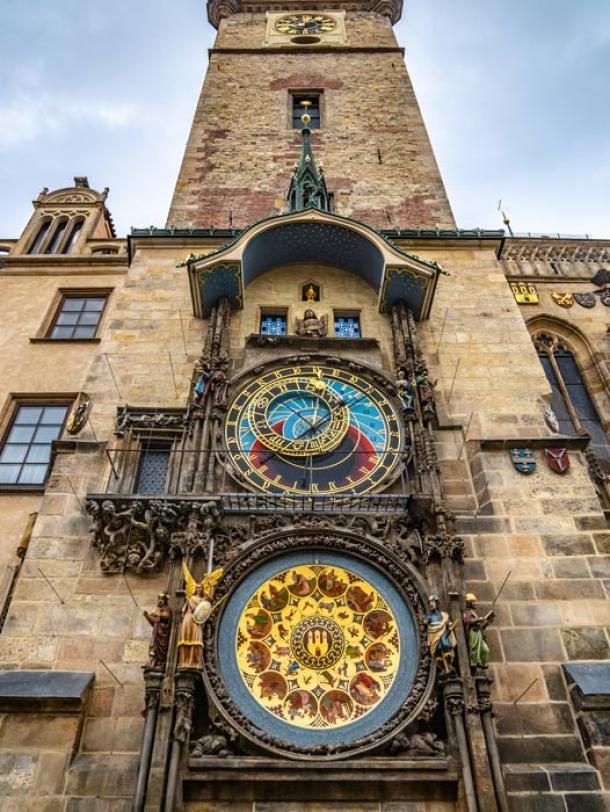
The astronomical clock in Prague, Czech Republic. ( JBJart /Adobe Stock)
Top Image: The Prague astronomical clock tower. Source: CC BY SA 3.0
By Caleb Strom
Updated on October 30, 2020.
Related posts:
Views: 0
 RSS Feed
RSS Feed

















 November 1st, 2020
November 1st, 2020  Awake Goy
Awake Goy 




 Posted in
Posted in  Tags:
Tags: 
















